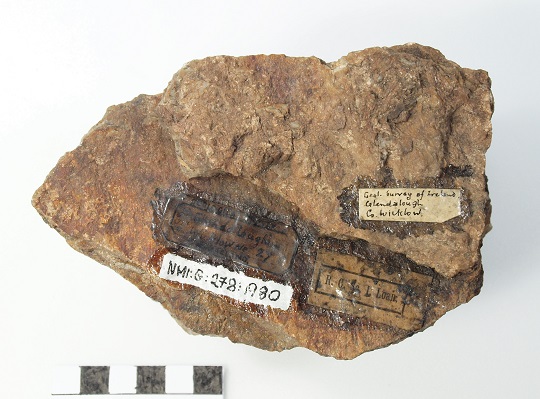Unknown
Lead-Bearing Minerals from Glendalough
The First World War and the Wicklow lead mines.
By Stephen CallaghanIntroduction
Minerals play an important role in everyday life, as if something can’t be grown it has to be mined. On a daily basis we use numerous objects which contain metals which were extracted from the ground at some point. Around this time a century ago there was a high demand for metals with World War One of the “Great War” as it was known at the time. One of those metals in constant demand was lead, for the use in munitions, such as bullets and in shrapnel shells. Before the opening of the Battle of the Somme offensive on 1st July 1916, over 1 million shells were used to try and destroy the German lines before the main attack, many of which were shrapnel shells. During the War the Ministry of Munitions invested money in reopening many old lead mines for the production of lead, one of the areas which saw investment were the mines at Glendalough.
Description
Figured above is a specimen showing a small section of a granitic mineral vein which exhibits the minerals galena (lead sulphide), which is metallic silver/grey in colour and some minor sphalerite (zinc sulphide), which is resinous brown colour, hosted in quartz, which is white.
In the museum’s acquisition register the entry for the mineral specimen is as follows: G:278:1980; GSI, RCSI Loan; Galena; banded in quartz veins; Wicklow; Glendalough.
Formation of mineral deposits in the Leinster granite
Concentrations of economically valuable minerals were deposited by hydrothermal fluids in fissures along the margins of the Leinster granite. These minerals included the lead-bearing mineral galena along with the zinc-bearing sphalerite these were also associated with minor amounts of copper and gangue minerals, the latter having little economic value and include minerals such and include quartz and calcite.

Mining in Glendalough and the First World War
Mining in the area dates back to around 1798 with the discovery of lead in the adjacent Glendasan valley during the construction of Military Road. Mining in the area ensued but profits always depended on the price and demand of metals. The mines in Glendalough were originally operated by the Mining Company of Ireland between 1825-1890. Afterwards the mines were taken over by the Wynne family who were locals and were working the mines between 1890-1925. During the Great War the mines in Glendalough became of interest to The Ministry of Munitions who gave the Wynne family £2,500, which they used to reopen Foxrock mine in Glendasan valley. It is likely that the lead produced from the mines during this time eventually saw its way into the manufacture of munitions destined to be used on the Western Front. When the war ended so did the funding and mining ceased in Glendalough, which was the last time the mines were ever worked.
How did this Specimen come to be in the Museum?
This specimen originally was in the collection of the Geological Survey of Ireland and then found its way into the collection of the Royal College of Science which was located on Merrion Street beside the Natural History Museum. While the exacts dates are not known this specimen along with others eventually found their way in the collection of the National Museum of Ireland and have resided here ever since.
Learn more
This specimen is part of the museum’s research collection and is not on public display, however there are displays of other Irish minerals along with the everyday uses of minerals on the ground floor of the Natural History Museum.
References
Cole, G. A. J (1998). Memoir of Localities of Minerals of Economic Importance and Metalliferous Mines in Ireland. 3rd ed. Dublin: Mining Heritage Society of Ireland.
Kennan, P. S., McArdle, P., Williams, F. M., Doyle, E. (1986). A review of metal deposits associated with the Leinster Granite, SE Ireland and a model for their genesis. In: Andrew, C. J., Crowe, R. W. A., Finlay, S., Pennell, W. M., Pyne, J. F. Geology and Genesis of Mineral Deposits in Ireland. Dublin: Irish Association for Economic Geology. 201-210.
Location:
Lead-Bearing Minerals from Glendalough is located at:
In Storage
Previous artefact:
Late Roman Amphora Sherds from Co. Waterford
Next artefact:
